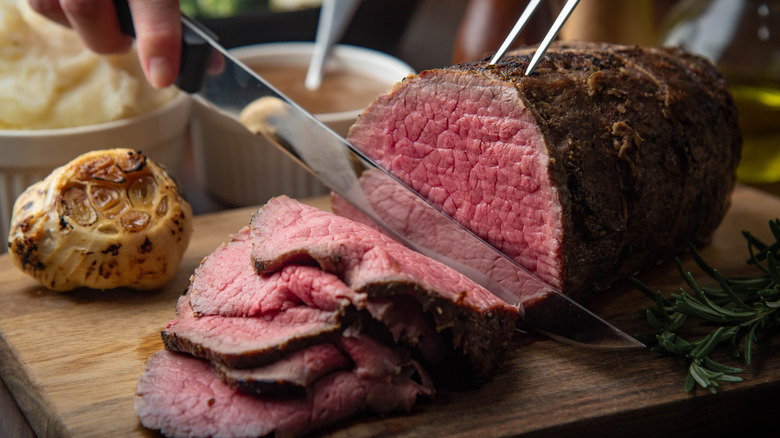Here Are The 2 Leanest Cuts Of Steak You Can Buy
There are all sorts of steak, from the incredibly tender filet mignon to the juicy ribeye to the more recently invented flat iron to the wildly underrated hanger steak. But what if, for whatever reason, you're looking for a particularly lean cut of steak with little to no fat marbling? Though these lean steaks do tend to be somewhat tougher, there are still reasons you might want one. So, what should you go with?
The good news is, you have options, as there's no shortage of beef cuts that fit the bill (and if you're willing to venture into other red meat aside from beef, you have even more choices). But if you're going for lean steak, there are two types you should be aware of in particular: eye of round and sirloin tip, also known as round tip. These two steaks share a lot in common, and though they need some extra attention owing to their leanness, they're ideal choices if you don't want a fatty steak.
Eye of round and sirloin share a lot of qualities
Eye of round is a particularly versatile and affordable steak sourced from the round primal, which is located in the rump and hind legs area of the cow. It often gets used as a roast — an obvious choice and a common theme among lean cuts of steak — but its uses go far beyond that. It often gets used in stews, sandwiches, or anything that requires an even cube or circular cut, since it tends to be uniform throughout. Eye of round is also an excellent choice for steak Milanesa, whose cook requires something particularly lean. It does tend to be relatively tough, so the ideal way to work with it is to marinate it and potentially even use a tenderizer to beat it into submission.
Much like eye of round, sirloin tip, aka round tip, comes from the rump and hind legs of the cow, and benefits from tenderizing techniques. Sirloin tip is particularly versatile, used in things like ground beef, roasts, and simple steaks. Unlike eye of round, sirloin tip does have a large ribbon of fat — but that fat runs along the outside of the cut, meaning it's easy to remove. Visually, sirloin tip might come in round cuts like eye of round, but it can also come in more elongated rectangular cuts (in which case it's sometimes referred to as sirloin tip side steak).
There are other types of lean steak, too
These may be the two leanest cuts of beef steak, but they're not the only lean cuts you can get. Top round steak also comes from the round primal and is one of the cuts often used in the grilled, marinated beef preparation known as London broil (which isn't even really British). Bottom round, unsurprisingly, is another round primal cut and is particularly good for both braising and jerky.
Top sirloin, meanwhile, is sometimes known as baseball steak and is noted for its particularly strong, beefy flavor and its similarity in appearance to a filet mignon. Kansas City strip steak, on the other hand, is lean and extremely tender and is sourced from the loin primal, located just below the cow's backbone — it's sometimes known as top loin. Chuck shoulder comes from a totally different part of the animal, up in the cow's shoulder area (the name is accurate), and is a common choice for pot roast as it's particularly noted for taking well to slow cooking.
Venison is another answer for lean steaks
If you want lean red meat and are willing to expand your steak horizons beyond the traditional beef, you also have other options. Specifically, you want to look at members of the ungulate family for one type of meat: venison, which can refer to deer, elk, caribou, moose, or reindeer. Much like beef, there are different cuts found on different parts of these animals, but the cuts generally share some similar qualities — namely, leanness as compared to their beef counterparts. Much like lean beef, this means you have to cook them quickly on high heat, but there are other things to be aware of with venison, too.
Venison is a game meat, meaning it's more likely to have that "gamey," somewhat metallic flavor. Fortunately, you can soak your venison in milk to avoid that gamey taste. You also have to be more careful with seasoning; because venison is so lean, excess salt can draw out the moisture you want to keep trapped in there. As such, the most important seasoning tip when cooking venison steaks is to salt after cooking.



